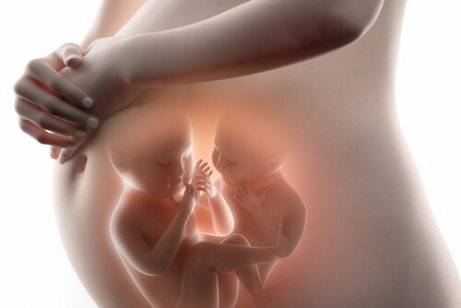Expecting Twins? Here's What You Need to Know about Delivery

Besides what you may have heard, natural vaginal childbirth is possible even when you’re expecting twins.
Of course, the possibilities of an intervention-free delivery will depend on two factors. First, the mother’s condition during pregnancy, and second, the position of the babies.
The gestation period is shorter than 40 weeks when it comes to multiple births. If the mother has had a normal pregnancy up until week 37, then the doctor may determine that vaginal childbirth is a viable option.
However, in high-risk pregnancies, your OB/GYN might opt for a C-section. Many specialists prefer this option from the start, so as to avoid any complications that could arise during delivery.
The position of the babies
The position that the twins are in is also a determining factor when it comes to the possibility of vaginal delivery. If both of the babies are situated head down, then your chances of giving birth naturally are much greater.
At the same time, vaginal childbirth still remains an option when the first baby is head down and the second is on his or her back. Once the first baby has already been born, then there’s a chance the second baby will rotate into the correct position.
However, if both babies are located in an upright position, then C-section is the only option. The same is true when both babies are in a horizontal position.
Furthermore, there are other conditions that have to do with the need for a C-section. For example, the risks associated with placenta previa, a mother’s narrow pelvis, premature loss of amniotic liquid, the expulsion of the umbilical cord ahead of the babies, etc.
Lastly, if the babies are premature, then C-section is the only option. The same is true when the babies share the same amniotic sac or present congenitive birth defects, such as with conjoined twins.

Vaginal delivery of twins
Giving birth vaginally to one baby is very similar to giving birth to multiple babies. In both cases, the birthing process can begin with contractions or when the mother’s water breaks (the opening of the amniotic sac).
In the case of contrations, the mother can wait until they reach a frequency of approximately every 5 minutes. Once in the hospital, the mother will need to wait until she reaches 10 centimeters dilation.
If the mother’s water has already broken, then it’s ok to wait, as long as the liquid is light in color. However, if the liquid is dark, then she should go to the hospital immediately.
When giving birth to twins, the interval between the birth of the first baby and the second is between 20 and 30 minutes. The process of expulsion tends to be faster because the babies are smaller.
In order to stabilize the babies quickly, nurses will take the babies directly to an incubator. After that, the mother will be able to nurse them.
Some recommendations if you’re expecting twins
- Attend a prenatal class. These preparation courses not only help parents get ready for the birthing process. They also allow mothers and fathers to share their experiences with other future parents.
- Do your research on the risks associated with multiple births. This isn’t about increasing your anxiety levels and fears about giving birth to twins. Rather, it’s about keeping emerging risks at bay. For example, the complications that can arise if the mother suffers from diabetes or hypertension. In those cases, the risk of hemorrhage is higher. The risk of other common complications like pressure on the umbilical cord or placenta also increases.
Premature birth is a common risk when it comes to twins. 50% of multiple births result in delivery prior to 37 weeks due to the weight of the babies and the size of the uterus.

- Choose your specialists. Given the heightened risk related to multiple births, it’s a good idea to have specialists around for the time of birth. If any problem occurs, a doctor will be able to take proper action. It’s important to have all the medical resources possible at your disposal. Furthermore, we recommend having two nurses in the room to improve efficiency.
- Arrange assistance for after your babies are born. The saying goes, “it takes a village to raise a child.” The birth of a baby presents a number of changes for a family. This is even more true when it comes to the birth of twins. Having a team of individuals to help and support you is vital when it comes to caring for two newborn babies.
Of course, the most important thing of all is that you remain calm and face the birthing process with a positive attitude. Look to your partner, friends and family to get the support you need before and after the arrival of your little ones.
All cited sources were thoroughly reviewed by our team to ensure their quality, reliability, currency, and validity. The bibliography of this article was considered reliable and of academic or scientific accuracy.
- Bateni ZH, Clark SL, Sangi-Haghpeykar H, et al. Trends in the delivery route of twin pregnancies in the United States, 2006–2013. Eur J Obstet Gynecol Reprod Biol. 2016;205:120-126. doi:10.1016/J.EJOGRB.2016.08.031
- Melka S, Miller J, Fox N. Labor and delivery of twin pregnancies. Obstet Gynecol Clin N Am 44 (2017) 645–654 http://dx.doi.org/10.1016/j.ogc.2017.08.004
This text is provided for informational purposes only and does not replace consultation with a professional. If in doubt, consult your specialist.








